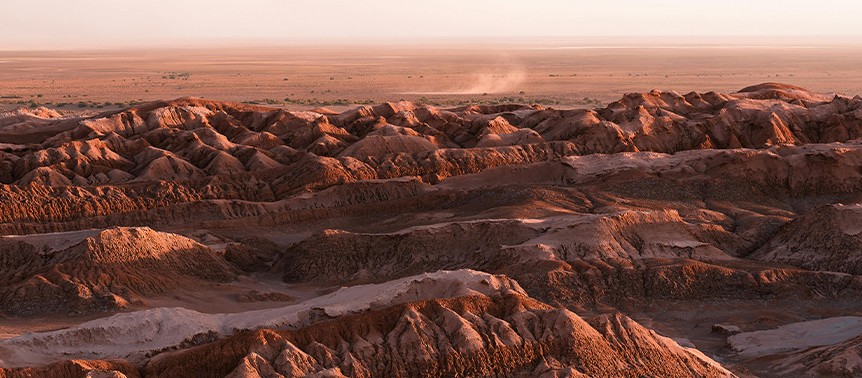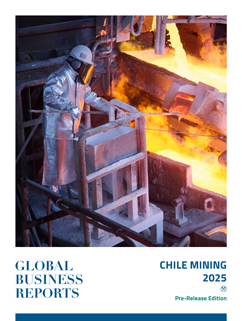A resilient industry rising to meet its challenges
RELATED PUBLICATION
ARTICLES FROM THIS PUBLICATION
Chile Reclaims its Mining Might

Image by Willian Justen at Pexels
After several years of challenges and uncertainty, the resiliency of Chile’s mining industry shines through in 2025. The path to foreign investment is more competitive than ever, and companies across the value chain are trying to break the downward trend of decreasing production levels that have plagued Chile since 2019. The annual total for copper production in 2024 was 5.5 million t, an increase of 4.9% from 2023’s figure. As the country emerges from the recent experiences of regulatory changes and an unsettled political attitude toward mining, it feels as though the world’s leading copper producer is back to its brightest. Furthermore, with an election on the horizon in November 2025, companies remain cautiously optimistic about the future of mining in Chile.
In December 2024, Cochilco (the Chilean Copper Commission) reported a monthly production of 563.4 thousand t of copper, the highest in Chile’s history and 14.1% higher than December 2023, which companies are hoping is a sign of things to come for 2025. “I think that the initial concerns have vanished over the years concerning the negative impact of the government through new regulations. Now, we are seeing an increase in investment in Chilean mining larger than in any other Latin American country. I believe that regardless of political affiliation, the new government will seek to speed up the environmental processes required to build and operate a mine without making the requirements any less stringent,” remarked Juan Castaño, CEO of consultants Amphos21 Chile.
The first months of 2025 have seen a surge in demand for copper, and this has been reflected in a price hike of 11.44%. Analysts attribute this to a weakening US dollar, geopolitical tensions, rising industrial demand, and the tariffs imposed by the US government, as well as the ongoing global shift toward renewable energy and electric vehicles. “The energy transition is irreversible, and while short-term challenges may arise, including geopolitical ones, the long-term trajectory is clear: an electrified world with decreasing reliance on fossil fuels. Copper’s fundamental role in electrification will drive significant copper demand, and with experts predicting a looming supply deficit, further investment is required,” said Santiago Montt, CEO of Los Andes Copper.
US President Trump has threatened a 25% tariff on all copper imports, sinking the price by up to 7.7% on the London Metals Exchange. This has made the outlook for future copper prices much less stable, with predictions previously estimated to be US$4.25 per lb in February 2026 now sitting around US$3.90. More uncertainty is affecting the short-term attitude of investors and buyers, however, in the long-term, hope remains a solution will be found, and Chile’s biggest export will remain an economic driver for the country.
Experts predict that demand for copper may grow by 27% before the end of the decade, with AI data centers, renewable solutions, and the EV market requiring 36.6 million t/y of the group 11 metal before 2031, according to McKinsey. “The demand for copper is forecast to remain strong thanks to mega-trends of electrification, economic development, and population growth. Net copper shortages will drive high prices needed to generate investment returns on the development of the lower-grade, more inaccessible deposits that are currently being studied,” explained Merlin Marr-Johnson, CEO of Fitzroy Minerals.
“One of our main initiatives is the National Geological Exploration Plan, in collaboration with the Association of Geologists. It aims to map Chile’s mineral resources region by region. This project, with a budget of US$4 million and an estimated duration of 24 to 36 months, will create jobs for geologists, engineers, environmental specialists, and archaeologists and will provide precise data on Chile’s mineral wealth to guide future mining investments,” said the Chilean Mining Chamber’s president, Manuel Viera Flores.
Codelco
In 2023, Codelco, Chile’s state-operated mining giant, recorded its lowest production figures in 25 years. Since then, all efforts have been directed at restoring the company’s former strength. In this vein, Codelco acquired Enami’s 10% stake in Quebrada Blanca for US$520 million aiming at increasing production at the plant and foster collaboration between Teck and Codelco.
Furthermore, in February 2025, alongside Anglo American, Codelco announced a historic MoU to collaborate on the neighboring Andina and Los Bronces projects. According to Codelco, this will become the fourth largest mining district in the world, possessing about 8 million t of resources between the two deposits. The collaboration will help both companies avoid many of the problems other mining companies in Chile are facing, such as access to infrastructure and declining ore grades, increasing production by 120,000 t/y. “Proper planning and foresight are necessary to ensure efficiency and continuity, even in the face of external disruptions. A concrete example is the merger between Codelco and Anglo American at Adina and Los Bronces, where strategic project geolocation and integration will drive future success,” said Julián Alvear Fernández, CEO of LEN Ingeniería.
Vicuña takes center stage
Another landmark collaboration in 2025 was announced at the beginning of the year between Lundin Mining and BHP, which acquired a large land package in the Vicuña District that straddles the Argentina- Chile border. The acquisition includes the Filo del Sol and Josemaria projects, and both companies will control 50% ownership of the newly created Vicuña Corp. “We expect the Vicuña project to become one of the largest copper projects in the coming decades. Having BHP as our partner in this project is a strong validation of our confidence in copper and its future demand,” outlined Juan Andrés Morel, vice president of operations for Lundin Mining.
NGEx Minerals is a junior company bullish on the future of the Vicuña district. In Chile, NGEx owns Los Helados, a project located about 17 km from the producing Caserones mine. The project is significant in size, with a 2 billion-t indicated resource base and another 1 billion t in inferred resources. Just across the border in Argentina, NGEx Minerals owns the Lunahuasi land package in San Juan, one of the most exciting copper-gold-silver projects currently being explored in the world, winning the PDAC Discovery of the Year award in 2024. Despite the relatively recent fame of the region, many years of effort have gone into developing what may be the next premier mining district in South America. “It’s easy to think of the Vicuña district as something that just sprung to life recently, when in fact it is the result of 20 years of investment through thick and thin. In a long-term business such as mining, you cannot let daily or even yearly metal prices influence your decisions. Much of the success we are enjoying today is because of investments made during tougher times decades ago,” emphasized Wojtek Wodzicki, president and CEO of NGEx Minerals.
It is yet to be seen what impact the rise of the Vicuña district will have on more historic mining regions in Chile, for example, Antofagasta. “Investment will continue coming into Chile, but emerging copper provinces will grab a bigger market share,” said Brandon Craig, president Americas of BHP.











